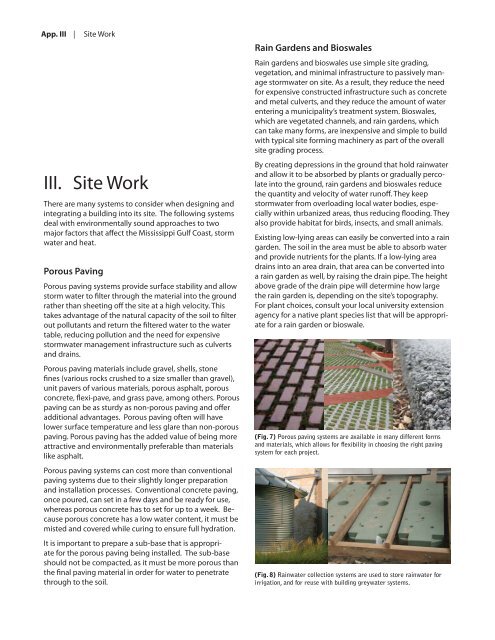Alternative Construction Research Guide - GCCDS
Alternative Construction Research Guide - GCCDS
Alternative Construction Research Guide - GCCDS
You also want an ePaper? Increase the reach of your titles
YUMPU automatically turns print PDFs into web optimized ePapers that Google loves.
App. III | Site WorkIII. Site WorkThere are many systems to consider when designing andintegrating a building into its site. The following systemsdeal with environmentally sound approaches to twomajor factors that affect the Mississippi Gulf Coast, stormwater and heat.Porous PavingPorous paving systems provide surface stability and allowstorm water to filter through the material into the groundrather than sheeting off the site at a high velocity. Thistakes advantage of the natural capacity of the soil to filterout pollutants and return the filtered water to the watertable, reducing pollution and the need for expensivestormwater management infrastructure such as culvertsand drains.Porous paving materials include gravel, shells, stonefines (various rocks crushed to a size smaller than gravel),unit pavers of various materials, porous asphalt, porousconcrete, flexi-pave, and grass pave, among others. Porouspaving can be as sturdy as non-porous paving and offeradditional advantages. Porous paving often will havelower surface temperature and less glare than non-porouspaving. Porous paving has the added value of being moreattractive and environmentally preferable than materialslike asphalt.Porous paving systems can cost more than conventionalpaving systems due to their slightly longer preparationand installation processes. Conventional concrete paving,once poured, can set in a few days and be ready for use,whereas porous concrete has to set for up to a week. Becauseporous concrete has a low water content, it must bemisted and covered while curing to ensure full hydration.It is important to prepare a sub-base that is appropriatefor the porous paving being installed. The sub-baseshould not be compacted, as it must be more porous thanthe final paving material in order for water to penetratethrough to the soil.Rain Gardens and BioswalesRain gardens and bioswales use simple site grading,vegetation, and minimal infrastructure to passively managestormwater on site. As a result, they reduce the needfor expensive constructed infrastructure such as concreteand metal culverts, and they reduce the amount of waterentering a municipality’s treatment system. Bioswales,which are vegetated channels, and rain gardens, whichcan take many forms, are inexpensive and simple to buildwith typical site forming machinery as part of the overallsite grading process.By creating depressions in the ground that hold rainwaterand allow it to be absorbed by plants or gradually percolateinto the ground, rain gardens and bioswales reducethe quantity and velocity of water runoff. They keepstormwater from overloading local water bodies, especiallywithin urbanized areas, thus reducing flooding. Theyalso provide habitat for birds, insects, and small animals.Existing low-lying areas can easily be converted into a raingarden. The soil in the area must be able to absorb waterand provide nutrients for the plants. If a low-lying areadrains into an area drain, that area can be converted intoa rain garden as well, by raising the drain pipe. The heightabove grade of the drain pipe will determine how largethe rain garden is, depending on the site’s topography.For plant choices, consult your local university extensionagency for a native plant species list that will be appropriatefor a rain garden or bioswale.(Fig. 7) Porous paving systems are available in many different formsand materials, which allows for flexibility in choosing the right pavingsystem for each project.(Fig. 8) Rainwater collection systems are used to store rainwater forirrigation, and for reuse with building greywater systems.
















